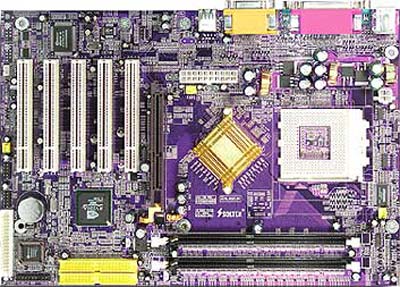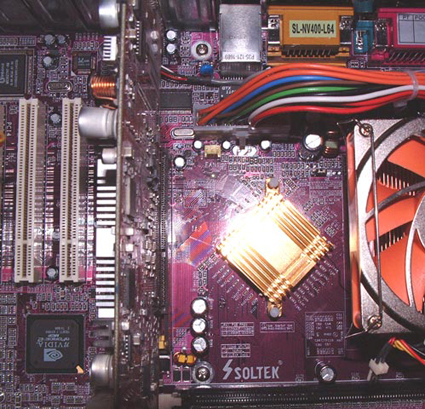Soltek NV400-L64: Purple, Practical, AND Performance!
by Wesley Fink on August 11, 2003 10:26 PM EST- Posted in
- Motherboards
Soltek NV400-L64: Board Layout
The Soltek has a decent layout for a low-end board. We say this because low-end boards often have some of the strangest layouts. When the manufacturer is aiming for a price point, economy of manufacture is often more important than ergonomics.
The first hint that the NV400-L64 may be a serious performer is the inclusion of both the standard 20-pin ATX connector and the AMD optional 4-pin 12V connector. While top-end AMD motherboards are implementing both of these standards, which are part of the Pentium 4 Power Supply specification, we were somewhat amazed to see both connectors on a value board. Regardless, the location of the 20-pin and the 4-pin power connectors are less than ideal. The 20-pin ATX is located to the left of the Northbridge chip, almost in the center of the board. This means you will have to snake the bulky 20-pin cable around your CPU socket and try to keep it from interfering with ventilation. We prefer a location as near to the top of the board as possible and to the right of the CPU. This works best in most case designs. The 4-pin 12V connector is in a common location, to the left of the CPU socket, but it is thankfully at the top of the board. While we prefer the 12V to the right of the CPU socket, between the CPU and DIMM slots and as close to the top of the board as possible, we can’t complain about Soltek’s positioning of the 12V connector — it does not interfere with air-flow or present cable-routing problems.
Fan connections are often in short supply on low-end boards, but Soltek includes three fan headers on the NV400-L64. This allows connection of up to three monitored fans to the board.

The passive heatsink used on the Northbridge has the advantage of not adding to system noise, but the one Soltek used on the NV400-L64 is much smaller than we have seen on other nForce2 boards. While it cooled effectively in our testing, it did get warmer than desired. Those planning any serious overclocking with this board may want to replace the Northbridge heatsink with a larger passive heatsink or an active cooling solution.
One advantage of a small passive or active Northbridge cooling solution is that it won’t interfere with mounting some of the larger CPU cooling solutions. There is plenty of room around the CPU socket, and we don’t believe mounting a large cooler on the CPU will create any problems. The Thermalright SK-7, which uses a clip for connection, fits with ease — even with an 80mm fan attached. However, there are no mounting holes around the CPU socket, which will be important to some. The mounting holes are not part of the current AMD specification, and we didn’t expect to find them on a value board, but they are important to many who use watercooling and very heavy heatsinks.
The Floppy connector and Primary/Secondary IDE connectors are all in compromised positions — predictable for a low-priced board. All three connectors are low on the board, which makes snaking cables more difficult. The floppy connector is in a particularly bad location, situated at the very bottom of the board. At least Soltek kept the connector to the far right of the board, which will minimize interference with slots. But Soltek is no worse than other low-end boards with respect to cable locations. A smaller board means less room to put things, and some of the small boards face some real challenges regarding layout. Our preference is closer to the top of the board, to the right of the DIMM slots; however the smaller board offers no room for the cable connections in that location.
If you have a case with drive bays to the right of the motherboard, the location of the IDE/Floppy connectors near the bottom right of the board will seem ideal. However, if your drives must mount in the upper bays of a tower case, you will probably hate the location of the IDE connectors. In the real world, users with full-tower cases will not likely choose a low-end board like the Soltek to go in their expensive cases. The Soltek layout, therfore, should work fine in the small to mid-size cases that will actually be used with this board.










35 Comments
View All Comments
Anonymous User - Saturday, October 25, 2003 - link
Hello All!!!I've been buying components last 6 months one at a time, and the Soltek Nv400L was my last purchace.
System Specs:
430 Watt Antec Power Supply
Athlon XP 2500 cpu
512 Corsair Xms c2pt memory-single stick
Ati 9500 pro 128 video card
Turtle Beach Santa Cruz sound card
1 80 gig Western Digital 8meg cache hard drive
1 80 gig Maxtor 8meg cache hard drive
Liteon 522446s Cd writer
Liteon 165h Dvd rom
Philips Brilliance 107p monitor
Windows XP professional
I don' need serial ata, my special editions are plenty fast for the dollars spent, serial needs to mature also. I had a Kt3ultra2, with pc2100 Infineon 512 stick, and a XP2000.
I was concerned about this upgrade, I don't trust cheap boards. Had real bad time with a ECS pos last year.
Let me tell you, my system right now, is THE best bang for the buck. I am so impressed. All I needed was the lan, and it too kills my pci network card. This Soltek mobo should not be understated, to say the very, very least. I also like the fact of just having my one stick of corsair, ranther than having 2 dual sticks. If you need all the "features", pass on it. If you want amazing speed, ultra reliability, and great overclocking (Soltek has O/C bios at request, FULL ram tweaking), grab this board.
I can't believe something this cheap is so damn fast, reliable.............
Don't be fooled people. Ya, I have no bragging rights, but I have a great little purple mobo on crack, HIGHLY SUGGESTED.
THIS IS THE MOST UNDERATED MOBO ON THE MARKET RIGHT NOW. ABSOLUTELEY. You don't hear much about it cause Nvidia etc. etc. is not getting rich off it. Its a gem.
Anonymous User - Wednesday, August 27, 2003 - link
Can't see the benchmarks, too. Using Netscape7 on Linux.Anonymous User - Monday, August 25, 2003 - link
Uhh... Did something happened to the benchmark pics? (They are not showing up) Anyone else experiencing this? or Is my browser acting up?Maybe another ongoing article update perhaps?
Anonymous User - Wednesday, August 20, 2003 - link
To the author,PCI bus speed runs at a fixed frequency for nForce2. It isn't half of the AGP bus speed. Please use a IOSS RD2 Pro PC Geiger PCI Bus Multifunction Analyzer to verify.
Anonymous User - Tuesday, August 19, 2003 - link
Jeff, stop posting, it's already known fact that Gigabyte's nForce2 U400 and other U400 motherboards perform exactly the same as Epox and ASUS's boards. Your argument request is useless, waste's Anandtech's time, and is getting old frankly.Anonymous User - Sunday, August 17, 2003 - link
I'm really surprised by the figures you guys obtained - I had an ASUS A7N8X-X (non-ultra) and it was crap! I could only get 8,000 in 3Dmark01, upon changing to the ASUS Ultra (deluxe) and keeping everything the same I got 13,500!!!!Also, my A7V8X-X was way faster (12,000 3DMark01) - Don't know why, maybe the A7N8X-X was not working correctly(?).
Jeff7181 - Sunday, August 17, 2003 - link
Again I ask... where the hell is the popular boards like the A7N8X Deluxe and 8RDA+?Anonymous User - Sunday, August 17, 2003 - link
is a7n8x-x anygood?Anonymous User - Saturday, August 16, 2003 - link
I am awaiting further testing on other nForce2 400/Ultra motherboard, e.g. chaintech 7njl3 or 7njl4 or gigabyte counterparts which are also very competitive in the market.wesley, hear my voice?!
Anonymous User - Saturday, August 16, 2003 - link
And one last question - is it not possible that the 'Auto' setting for memory speed actually runs the memory in sync with FSB? I just want to be sure.